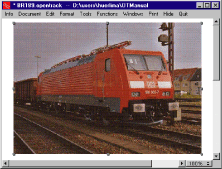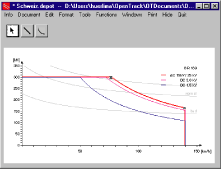La Microsimulazione di reti ferroviarie
  |
This page is also available in English. |
  |
Diese Seite ist auch auf Deutsch verfügbar. |
  |
Cette page est disponible en Français. |
 |
Esta página está también disponible en Español. |
Contenuti
- News / Eventi
- Introduzione
- Dati
- Simulazione
- Headway Calculator
- Screenshots
- Outputs
- OpenTrack API
- Partners e utenti
- Documenti / Downloads
- Video
- Maggiori informazioni
News
| Data: | News: |
| Marzo 2017 | Presentazione di OpenTrack al ZRS in Doboj, Republika Srpska. |
| Settembre 2017 | OpenTrack Railway Technology Vienna partecipa al Progetto Europeo GoSafe Rail. |
| Gennaio 2018 | La rivista specializzata serba Železnice (Ferrovia) pubblica un articolo su OpenTrack. |
Eventi
| Data: | Luogo: | Evento: |
| 16 - 20 Luglio, 2018 | Sydney (Australia) | OpenTrack Training Course |
| 18 - 21 Settembre, 2018 | Berlino (Germania) | InnoTrans 2018 - International Trade Fair for Transport Technology |
L'ultimo workshop degli utenti OpenTrack si è tenuto a Zurigo dal 7 al 9 Settembre 2017 a Losanna, presso lo Swiss Federal Institute of Technology (ETH Lausanne, EPFL). Nella sezione dedicata ai workshop degli utenti di questa pagima è possibile scaricare tutte le presentazioni.
Introduzione
Opentrack é stato sviluppato a partire dalla seconda metà degli anni 90 come progetto di ricerca al Politecnico Federale di Zurigo. Lo scopo del progetto era lo sviluppo di uno strumento software di facile utilizzo in grado di analizzare o sistemi ferroviari attraverso la modellizzazione e simulazione dell'esercizio.
Oggi Opentrack è uno strumento maturo e collaudato, utilizzato da gestori dell'infrastruttura, imprese di trasporto, industrie di settore, società di consulenza e università in molti paesi in tutto il mondo.
OpenTrack consente di modellizzare, simulare e analizzare i seguenti tipi di sistema di trasporto a guida vincolata:
- Ferrovie ad Alta Velocità
- Ferrovie tradizionali
- Ferrovie regionali
- Ferrovie per trasporto merci pesante
- Sistemi ferroviari minerariMining
- Metropolitane
- Ferrovie leggere (Light Rail Transit)
- Tranvie
- People mover
- Ferrovie a cremagliera
- Treni a levitazione magnetica
OpenTrack fornisce supporto, tra le altre, per le seguenti attività:
- Pianificare e definiere le caratteristiche delle infrastrutture future
- Analizzate la capacità di linee e nodi in condizioni di esercizio
- Calcolo del distanziamento minimo (haedway) tra due rotabili, attraverso l'Headway Calculator
- Studi sul materiale rotabile (ad esempio fissarne i requisiti prestazionali o il fabisogno)
- Calcolo del tempo di percorrenza
- Costruire e valutare la robustezza degli orari (utilizzando anche simulazioni ricorsive Monte Carlo)
- Analizzare diversi sistemi di segnalamento, come sezioni di blocco fisse, sezioni di blocco corte, blocco mobile, LZB, CBTC (communication-based train control), ATP, ATO, ETCS Livello 1, ETCS Livello 2, ETCS Livello 3 Ibrido, ETCS Livello 3
- Valutare gli effetti di guasti (ad esempio all'infrastruttura o ai treni) e ritardi
- Calcolare il consumo di energia dei treni
- Simulare sistemi di alimentazione elettrica per la trazione ferroviaria (in combinazione con OpenPowerNet)
Dati
Infrastruttura
Opentrack rappresenta le reti ferroviarie mediante un particolare tipo di grafo chiamato Double Vertex Graph. La topologia viene inserita mediante un editor grafico. I diversi elementi (archi, segnali, ecc...) contengono una serie di attributi che ne rappresentano le principali caratteristiche. Ad esempio, un arco ha una data lunghezza, pendenza longitudinale, velocità per i diversi ranghi. Allo stesso modo, anche le caratteristiche ed il funzionamento dei sistemi di blocco e sicurezza e gli itinerari sono gestibili dall'utente. La figura seguente mostra un esempio di topologia.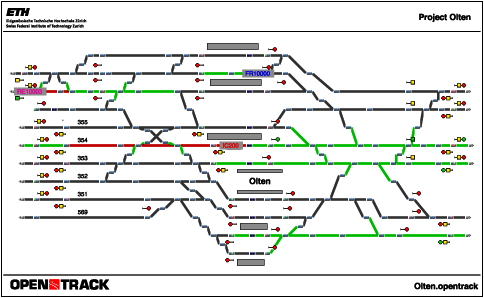
Esempio di stazione (Olten, CH). L'immagine é scaricabile come PDF document.
Materiale Rotabile
OpenTrack utilizza i dati tecnici di ogni locomotiva e treno, tra cui il diagramma di sforzo di trazione/velocità, la massa, la lunghezza e il peso aderente. In uno specifico database le locomotive sono organizzate in gruppi; un treno simulato ha una composizione formata da una locomotiva (o treno automotore) ed un certo numero di carrozze o carri. Anche le composizioni così definite vengono salvate e gestite tramite un database.Orario
Un altro database contiene l'orario dei treni, definito da partenze, transiti e arrivi, tempi minimi di fermata e gli eventuali vincoli di coordinamento o coincidenze con altri servizi.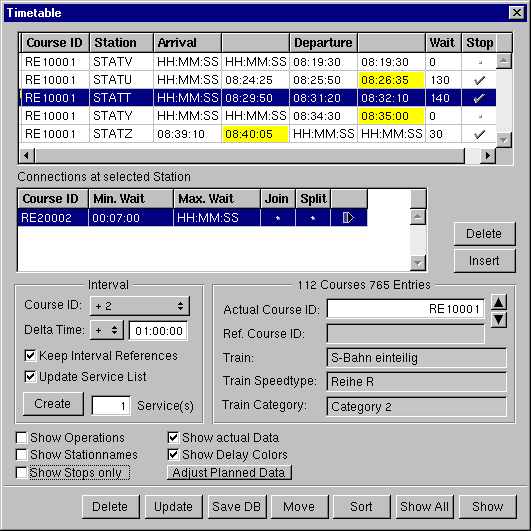 |
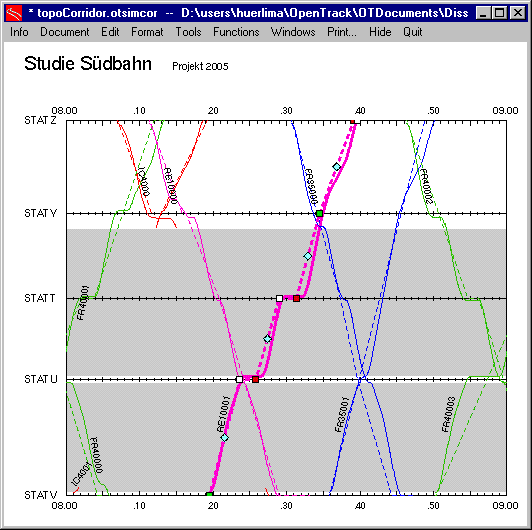 |
L'orario può essere modificato da tabella (a sinistra) oppure direttamente con il mouse sull'orario grafico (a destra). Vedi anche la sezione video.
Le differenze tra orario pianificato e simulato sono osservabili sia nella tabella dell'orario che sull'orario grafico.
Interfacce
OpenTrack si interfaccia con altri software mediante diversi formati standard (ASCII e XML) o proprietari (tra cui FBS, Protim, Simu VII).
OpenTrack supporta anche RailML, un formato XML standard per le applicazioni ferroviarie. Download della documentazione tecnica del formato railML (PDF-File, 800 kB).
| Orario | ||
| railML (Versions 1.0 and 2.2) | ||
| ASCII | ||
| MS Excel | ||
| OpenTrack ASCII | ||
| OpenTrack XML | ||
| Viriato (via railML) | ||
| FBS (via railML) | ||
| OpenTimeTable (via railML) | ||
| Simu VII (IBS GmbH) | ||
| UK Planning Inferface Format (.PIF-Format, Protim) | ||
| SimWalk (via railML) |
| Infrastruttura | ||
| railML (Versions 1.0 and 2.2) | ||
| ASCII | ||
| MS Excel | ||
| Google Earth (station data) | ||
| OpenTrack ASCII | ||
| SBB ZLR | ||
| Siemens Infrastructure Format | ||
| ETC Infrastructure Format | ||
| SIMON (ÅF-Industriteknik) | ||
| Infraspeed Infrastructure Format | ||
| Bentley Rail Track |
| Dati sul materiale rotabile (diagramma Sforzo di trazione/velocità) | ||
| railML (Versions 1.0 and 2.2) | ||
| OpenTrack ASCII | ||
| SimWalk (via railML) |
Simulazione
La figura seguente mostra il funzionamento del simulatore. I treni predefiniti si muovono su una rete secondo l'orario. Durante la simulazione, OpenTrack calcola gli spostamenti dei treni rispettando il funzionamento dei sistemi di distanziamento e l'orario. OpenTrack consente di analizzare e visualizzare i risultati della simulazione sotto forma di diagrammi, orari grafici e statistiche.OpenTrack esegue simulazioni singole o ricorsive, nelle quali sono riprodotte le reali distribuzioni stocastiche dei ritardi in partenza e nelle diverse stazioni intermedie.
Animazione della simulazione
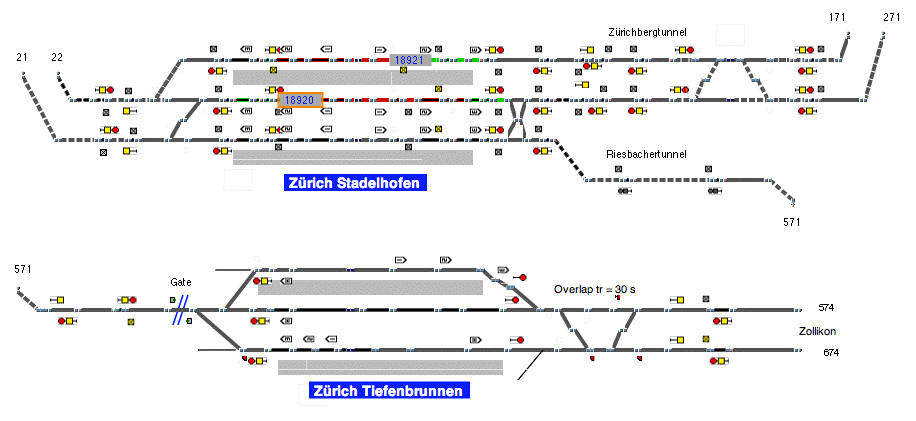
Nello screenshot é raffigurato un istante di una simulazione. É disponibile anche il filmato completo scaricabile.
Nello schema seguente è rappresentata l'archiettturo logica di OpenTrack.
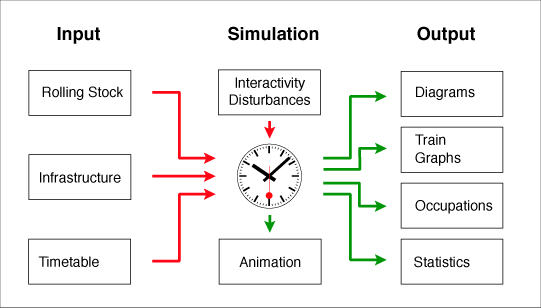
L'immagine é scaricabile come documento PDF
Durante la simulazione, I treni tentano di rispettare l'orario pianificato. Per rappresentare la dinamica di ciascun treno,
OpenTrack ne risolve l'equazione differenziale del moto rispettando i vincoli posti dal sistema di distanziamento e dai segnali.
Sezioni di blocco occupate e aspetti restrittivi dei segnali rallentano o fermano i treni.
La velocità, l'accelerazione, la posizione, il consumo di energia e molti altri dati di ogni treno sono memorizzati ad ogni istante
di simulazione su specifici file, per essere analizzati al termine della simulazione.
La simulazione può essere eseguita in tempo reale, mediante un'animazione che mostra il movimento dei treni lungo la rete, le corrispondenti occupazioni dell'infrastruttura e gli aspetti dei segnali.
Headway Calculator / Calcolo del distanziamento minimo
Sulla base di una serie di parametri impostati dell'utente, l'Headway Calculator calcola il distanziamento minimo tra due treni e consente di individuare la sezione di blocco critica. I due treni utilizzati per i calcolo possono essere diversi per tipoligia (es. lunga percorrenza, regionali, merci, ecc.), per instradamento e punti di fermata. Il calcolo del distanziamento minimo è possibile sia per sistemi a blocco fisso che mobile e per sistemi CBTC.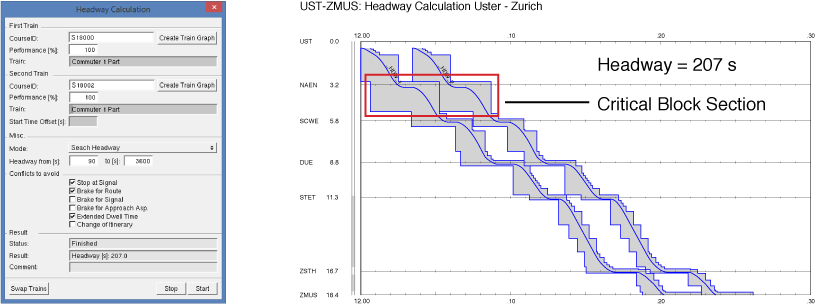
I grafici precedenti sono scaricabili in formato PDF.
Risultati della simulazione (Output)
Dopo una simulazione, OpenTrack offre svariate possibilità di rappresentazione ed analisi dei risultati. Per ogni treno, OpenTrack può rappresentare diagrammi come ad esempio spazio/accelerazione o spazio/tempo; orari grafici, occupazioni e profili di linea. Diverse statistiche per ogni stazione sono inoltre possibili.Tutti gli output sono visualizzabili come diagrammi o esportati su file ASCII.
Il software OpenTrack
OpenTrack può essere utilizzato con i sistemi operative Windows (XP, Vista, 7 -32 e 64 Bit-, 8 - 32 e 64 Bit-, 10 -32 e 64 Bit-) e Mac (OS X e OS X Server).L'applicazione é disponibile in due versioni. La versione completa di OpenTrack offre un numero illimitato di treni per simulazione. La versione Light invece é limitata a due treni per simulazione.
Screenshots
Le immagini seguenti rappresentano alcuni esempi dell'interfaccia di OpenTrack con diverse versioni di Windows o Mac OS X.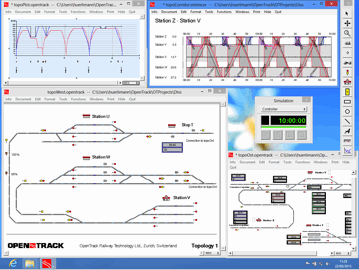 |
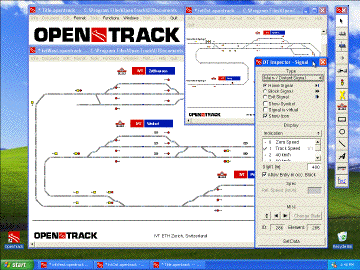 |
 |
| Windows 8 | Windows XP | MacOS X |
Output
OpenTrack consente la visualizzazione dei risultati della simulazione sotto forma di testo o grafici.
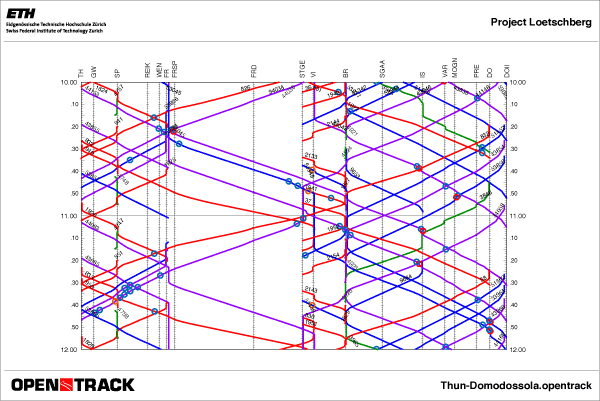
Orario grafico. L'immagine é scaricabile come documento PDF.
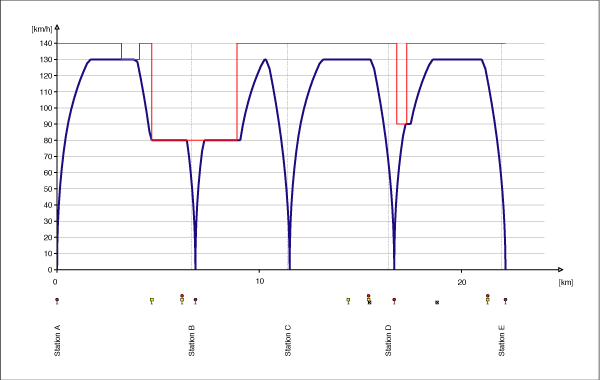
Diagramma spazio/velocità
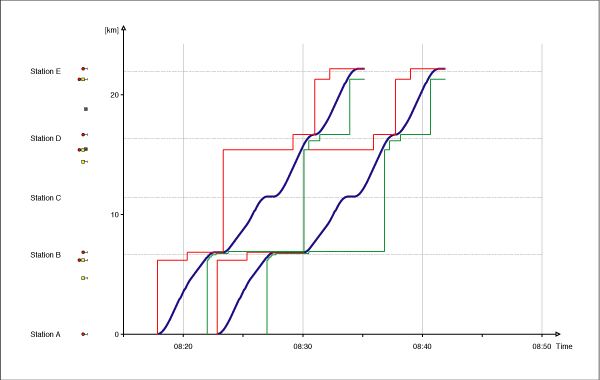
Diagramma spazio/tempo e gradini di occupazione

Diagramma del consumo elettrico e potenza erogata (in rosso la potenza erogata, in blu la potenza meccanica, in verde energia/distanza)
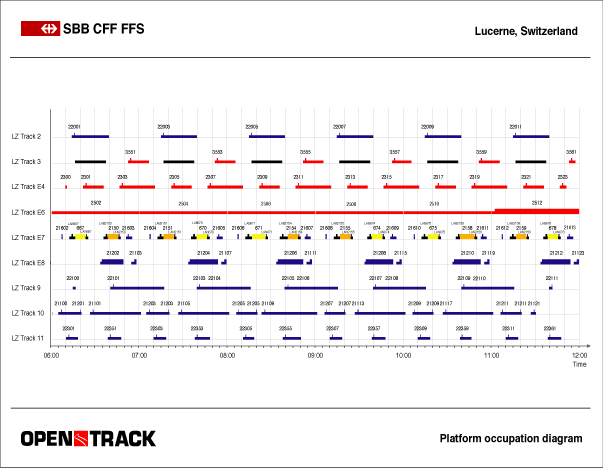
Diagramma di occupazione dei binari di stazione
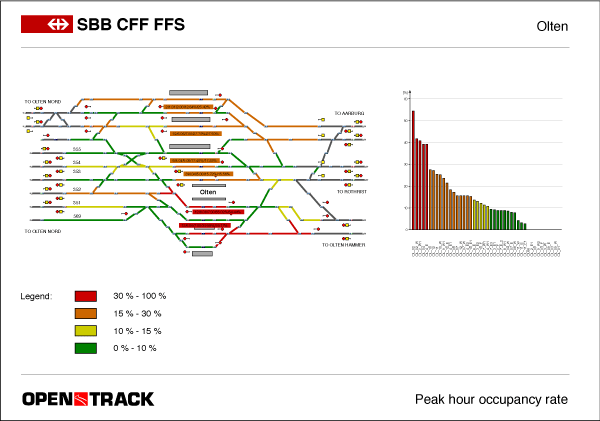
Statistiche sull'occupazione dell'infrastruttura (nell'esempio la percentuale di occupazione in ora di punta). L'immagine é scaricabile come documento PDF.
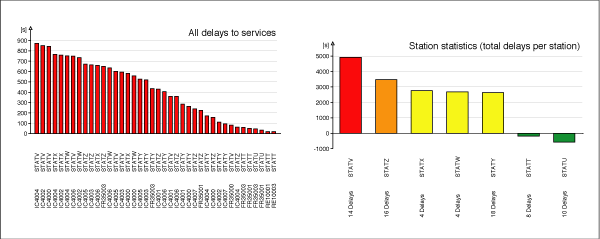
Statistiche dei ritardi
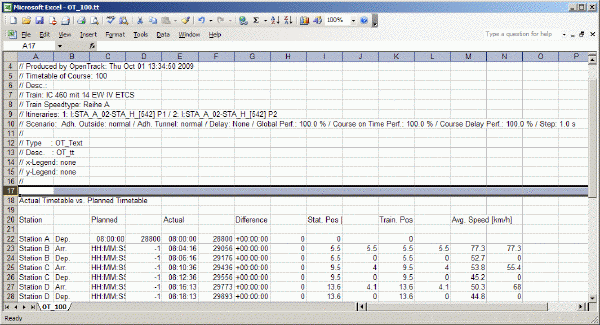
Tutti gli output vengono anche salvati come file di testo ASCII, per essere poi importati e analizzati in altri software, come Microsoft Excel.
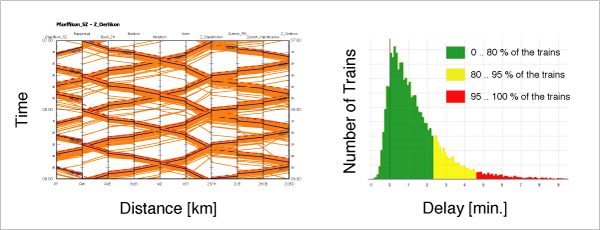
OpenTimeTable é in grado di visualizzare ed analizzare gli output di più simulazioni OpenTrack.
OpenTrack API
OpenTrack offre anche un Application Programming Interface (API) attraverso cui è possibile collegare altri astrumenti software a OpenTrack.
In questo modo l'altro strumento software può inviare comandi standardizzati a OpenTrack e ricevere da questo predefiniti messaggi sullo stato dei vari oggetti gestiti da OpenTrack.
Da un punto di vista tecnico, vengono scambiti SOAP-Messages attraverso HTTP (SOAP over HTTP).

Possibili applicazioni dell'API:
- Implementazione di algoritmi per la gestione degli instradamenti dei treni specifici per il cliente
- Confronto dta diverse modalità di gestione degli instradamenti
- Sviluppo e analisi di nuovi prototipi di sistemi di controllo della marcia dei treni (es. per l'ottimizzazione del consumo energetico,
per il contenimento dei ritardi e la riduzione dei conflitti nella circolazione, ecc.)
Una presentazione consente uno sguardo più approfondito sulle funzionalità dell'API di OpenTrack (PDF-File, 2.9 MB). Per maggiori informazioni, contataci.
Partner e clienti
La nostra società e l'Istituto di Pianificazione e Sistemi di Trasporto del Politecnico di Zurigo collaborano con numerose società ferroviarie e di consulenza per lo sviluppo del software. Le seguenti società ed istituti utilizzano OpenTrack:
Compagnie Ferroviarie e Gestori dell'Infrastruttura
 |
Swiss Federal Railways, Bern, Switzerland | dal 1999 | |
 |
REFER E.P., Rede Nacional Ferroviaria (National Railway Network)l, Lisbon, Portuga | dal 2000 | |
 |
Rhaetian Railways, Chur, Switzerland | dal 2002 | |
 |
TransAdelaide, Adelaide, Australia | dal 2002 | |
 |
German Railways, Frankfurt a. M., Germany | dal 2002 | |
 |
Finnish Rail Administration (RHK), Helsinki, Finland | dal 2004 | |
 |
V/Line, Melbourne, Australia | dal 2004 | |
 |
Ferrovie Nord Milano, Milano, Italy | dal 2004 | |
 |
Northern Ireland Railways, Belfast, UK | dal 2005 | |
 |
BLS Loetschbergbahn AG, Bern, Switzerland | dal 2005 | |
 |
ProRail, Rotterdam, The Netherlands | dal 2005 | |
 |
Circumvesuviana, Naples, Italy | dal 2005 | |
 |
VR Track Ltd., Helsinki, Finland | dal 2006 | |
 |
KiwiRail - New Zealand Railways Corporation, Wellington, New Zealand | dal 2008 | |
 |
NSB, Oslo, Norway | dal 2009 | |
 |
Ferrovie Nord Barese, Bari, Italy | dal 2009 | |
 |
Jernbanedirektoratet (Norwegian Railway Directorate, former Jernbaneverket), Oslo, Norway | dal 2009 | |
 |
SZDC (Czech Railway Infrastructure Administration), Prague, Czech Republic | dal 2009 | |
 |
Ferrovie del Sud Est, Bari, Italy | dal 2009 | |
 |
SNCF (Société Nationale des Chemins de Fer Français), Metz, France | dal 2009 | |
 |
Ferrovie del Gargano, San Severo, Italy | dal 2009 | |
 |
Victoria - Department of Transport, Melbourne, Australia | dal 2010 | |
 |
FAL - Ferrovie Appulo Lucane, Bari, Italy | dal 2010 | |
 |
FCU - Ferrovie Centrale Umbra, Perugia, Italy | dal 2010 | |
 |
ADIFSE - Administración de Infraestructuras Ferroviarias, Buenos Aires, Argentina | dal 2010 | |
 |
RFI - Rete Ferroviaria Italiana, Rome, Italy | dal 2010 | |
 |
Regione Umbria, Perugia, Italy | dal 2011 | |
 |
Ferrovie Emilia Romagna, Bologna, Italy | dal 2011 | |
 |
Réseau Ferré de France, Paris, France | dal 2011 | |
 |
Queensland Rail, Brisbane, Australia | dal 2012 | |
 |
Ferrocarrils de la Generalitat de Catalunya (FGC), Barcelona, Spain | dal 2013 | |
 |
Auckland Transport, Auckland, New Zealand | dal 2014 | |
 |
Taiwan High Speed Rail Corporation, Taipei, Taiwan | dal 2014 | |
 |
Saudi Railway Company, Riyadh, Kingdom of Saudi Arabia | dal 2014 | |
 |
CPTM, São Paulo, Brazil | dal 2014 | |
 |
Sitarail, Abidjan, Ivory Coast | dal 2014 | |
 |
PKP Polskie Linie Kolejowe, Warsaw, Poland | dal 2014 | |
 |
Aurizon, Brisbane, Australia | dal 2015 | |
 |
Public Transport Authority (PTA), Perth, Australia | dal 2016 | |
 |
SNCF - Innovation & Research, Paris, France | dal 2016 | |
 |
NS - Nederlandse Spoorwegen, Utrecht, The Netherlands | dal 2016 | |
 |
Ethiopian Railways Corporation (ERC), Addis Ababa, Ethiopia | dal 2016 | |
 |
KTMB, Kuala Lumpur, Malaysia | dal 2017 | |
 |
Grupo EFE, Santiago, Chile | dal 2017 | |
 |
Željeznice Republike Srpske (ŽRS), Doboj, Bosnia and Herzegowina | dal 2017 | |
 |
Metrolinx, Toronto, Canada | dal 2017 | |
 |
First Rail, London, UK | dal 2017 | |
 |
Bangkok Airport Rail Link (ARL), Bangkok, Thailand | dal 2017 | |
 |
SETRAG, Libreville, Gabon | dal 2018 | |
 |
Ferrocarriles del Sur (FESUR), Concepción, Chile | dal 2018 | |
 |
Empresa de Planejamento e Logística (EPL), Brazil, Brasilien | dal 2018 |
Metro and tram operators
 |
De Lijn, Hasselt, Belgium | dal 2007 | |
 |
Metro Santiago, Santiago, Chile | dal 2008 | |
 |
TfGM (Transport for Greater Manchester), Manchester, UK | dal 2009 | |
 |
RATP (Régie autonome des transports Parisiens), Paris, France | dal 2009 | |
 |
Guangzhou Metro, Guangzhou, China | dal 2010 | |
 |
Shenzhen Metro, Shenzhen, China | dal 2011 | |
 |
MetroRio, Rio de Janeiro, Brazil | dal 2012 | |
 |
Transport for London, London Tramlink, London, UK | dal 2013 | |
 |
Beijing Subway, Beijing, China | dal 2013 | |
 |
Macau LRT, Macau | dal 2014 | |
 |
Move São Paulo, São Paulo, Brazil | dal 2014 | |
 |
Metro de Lima, Lima, Peru | dal 2014 | |
 |
Sporveien Oslo, Oslo, Norway | dal 2014 | |
 |
MTR Corporation, Hong Kong | dal 2014 | |
 |
Seoul Metro, Seoul, Korea | dal 2015 | |
 |
Metro de Medellín, Medellín, Colombia | dal 2016 | |
 |
Helsinki Region Transport - HSL, Helsinki, Finland | dal 2016 | |
 |
Land Transport Authority - LTA, Singapore | dal 2016 | |
 |
ATM, Milano, Italy | dal 2017 | |
 |
RET, Rotterdam, The Netherlands | dal 2017 | |
 |
Bangkok Expressway and Metro (BEM), Bangkok, Thailand | dal 2017 | |
 |
SMRT Corporation Ltd, Singapore | dal 2018 |
Industrie
 |
Siemens AG, Wallisellen, Switzerland / Berlin, Germany / Brunswick, Germany / Brisbane, Australia | dal 1999 | |
 |
Infraspeed, Zoetermeer, The Netherlands | dal 2002 | |
 |
Mipro Oy, Mikkeli, Finland | dal 2004 | |
 |
BAM Rail, Breda, The Netherlands | dal 2005 | |
 |
Bombardier Transportation , Pittsburgh, USA / Stockholm, Sweden / Derby, UK | dal 2006 | |
 |
Consorzio TAT, Bodio, Switzerland and Implenia AG, Lucerne, Switzerland | dal 2007 | |
 |
Fortescue Metals Group Ltd, Perth, Australia | dal 2010 | |
 |
Vale, Maputo, Mozambique | dal 2011 | |
 |
Hyundai Rotem, Seoul, Korea | dal 2011 | |
 |
Alstom Transport, Bologna, Italy / Charleroi, Belgium / Madrid, Spain / Sydney, Australia | dal 2012 | |
 |
ABB - Asea Brown Boweri S.A., Madrid, Spain / Guarulhos, Brazil | dal 2012 | |
 |
Posco Engineering Co. Ltd., Seongnam-city, Korea | dal 2013 | |
 |
GE Transportation, Paris, France | dal 2013 | |
 |
Thales Portugal SA, Parço de Arcos, Portugal | dal 2013 | |
| ICONTROLS, Seongnam-Si, Korea | dal 2014 | ||
 |
Raytheon, Dulles VA, USA | dal 2014 | |
 |
Krauss-Maffei Wegmann, Munich, Germany | dal 2014 | |
 |
ComSource, Frederick MA, USA | dal 2014 | |
 |
Toshiba Corporation, Kawasaki, Japan | dal 2014 | |
 |
Hitachi Ltd., R&D, Yokohama, Japan | dal 2015 | |
 |
PSI Transcom, Berlin, Germany | dal 2016 | |
 |
Shinwoo ENG Co., Ltd., Seoul, Korea | dal 2016 | |
 |
IBM Singapore, Singapore | dal 2016 | |
 |
DAEATI Co., Ltd., Gyeonggi-Do, Korea | dal 2016 | |
 |
Meidensha Corporation, Tokyo, Japan | dal 2016 | |
 |
CRRC Corporation Limited, Beijing, China | dal 2016 | |
 |
BHP Billiton, Melbourne, Australia | dal 2017 |
Società di consulenza
 |
SMA und Partner AG, Zurich, Switzerland | dal 1999 | |
 |
ETC Transport Consultants GmbH, Berlin, Germany | dal 1999 | |
 |
Pöyry Infra AG, Zurich, Switzerland | dal 1999 | |
 |
REFER Engineering, Lisbon, Portugal | dal 2000 | |
 |
EBP, Zurich, Switzerland | dal 2001 | |
 |
NET engineering, Monselice, Italy | dal 2001 | |
 |
Institut für Bahntechnik (Inst. for Railway Engineering), Dresden, Germany | dal 2001 | |
 |
Plateway Pty Ltd, Sydney, Australia | dal 2001 | |
 |
Movares Nederland, Utrecht, The Netherlands | dal 2003 | |
 |
systransis Ltd, Zug, Switzerland | dal 2003 | |
 |
SNC-Lavalin Rail & Transit, Derby, UK / Sydney, Australia / Vancouver, Canada | dal 2004 | |
 |
Tyréns AB, Kristianstad, Sweden | dal 2005 | |
 |
COWI, Lyngby, Denmark / Oslo, Norway / Wroclaw, Poland | dal 2005 | |
 |
Royal HaskoningDHV, Amersfoort, The Netherlands | dal 2005 | |
 |
Egis Rail, Lyon, France | dal 2006 | |
 |
TTK - TransportTechnologie-Consult Karlsruhe GmbH , Karlsruhe, Germany | dal 2007 | |
 |
Norconsult AS, Sandvika, Norway | dal 2007 | |
 |
Laboratorio di Ingegneria Ferroviaria e Traffico, Trieste, Italy | dal 2008 | |
 |
IBV Hüsler AG, Zurich, Switzerland | dal 2008 | |
 |
TPS Transport Planning Service, Perugia, Italy | dal 2008 | |
 |
Booz Allen Hamilton, Newark NJ, USA | dal 2008 | |
 |
Dessau Inc. , Montréal, Canada | dal 2008 | |
 |
Geodata SpA, Torino, Italy | dal 2008 | |
 |
Ramboll, Stockholm, Sweden / Espoo, Finland / Virum and Fredericia, Denmark / Karlsruhe, Germany | dal 2008 | |
 |
WorleyParsons Services Pty Ltd, Sydney / Perth, Australia | dal 2008 | |
 |
Emch + Berger AG, Berne, Switzerland | dal 2009 | |
 |
Aurecon, Brisbane, Australia | dal 2009 | |
 |
D’Appolonia, Genova, Italy | dal 2009 | |
 |
DB International, Berlin, Germany | dal 2009 | |
 |
SIYUAN (China Railway Siyuan Survey And Design Group Co.), Wuhan, China | dal 2009 | |
 |
Italferr, Rome, Italy | dal 2009 | |
 |
Calibre Rail, Perth / Brisbane, Australia | dal 2009 | |
 |
ILF - Consulting Engineers, Zurich, Switzerland | dal 2010 | |
 |
TSD Consulting Services, Randburg, South Africa | dal 2010 | |
 |
Rail Systems Engineering Sdn. Bhd., Kuala Lumpur, Malaysia | dal 2010 | |
 |
JG Afrika, Cape Town, South Africa | dal 2011 | |
 |
Aurecon, Pretoria, South Africa | dal 2011 | |
 |
WSP, Sydney, Australia / Hong Kong / Newark NJ, USA / Toronto, Canada | dal 2011 | |
 |
Főrmterv, Budapest, Hungary | dal 2011 | |
 |
SYSTRA, Paris, France | dal 2011 | |
 |
The Third Railway Survey and Design Institute, Tianjin, China | dal 2011 | |
 |
The China Railway Eryuan Engineering Group Co. Ltd., Chengdu, China | dal 2011 | |
 |
CH2M, Parsippany NJ, USA | dal 2011 | |
 |
SIGNON, Berlin, Germany | dal 2012 | |
 |
Vecturis, Brussels, Belgium | dal 2012 | |
 |
Ingérop, Courbevoie, France | dal 2012 | |
 |
Prodex spol. s.r.o., Bratislava, Slovakia | dal 2012 | |
 |
Engenicom, Maitland NSW, Australia | dal 2012 | |
 |
Setec Ferroviaire and Setec its, Paris, France | dal 2012 | |
 |
Parsons, Markham Ontario, Canada | dal 2013 | |
 |
Yapi Merkezi Insaat, Istanbul, Turkey | dal 2013 | |
 |
taktici.cz, s.r.o., Praha, Czech Republic | dal 2013 | |
 |
SENER, Barcelona, Spain | dal 2013 | |
 |
Hatch, Mississauga and Montréal, Canada / Woodmead, South Africa | dal 2013 | |
 |
Nippon Koei Co., Ltd., Tokyo, Japan | dal 2013 | |
 |
China Railway Engineering Consulting Group Co., Beijing, China | dal 2014 | |
 |
Aarvee Associates, Hyderabad, India | dal 2014 | |
 |
Sintra, Mexico City, Mexico | dal 2014 | |
 |
Beijing Urban Construction & Development Group Co., Beijing, China | dal 2014 | |
 |
Paragon Tecnologia Ltda, São Paulo, Brazil | dal 2014 | |
 |
TRENECON COWI, Budapest, Hungary | dal 2014 | |
 |
BBF Sp. z o.o., Poznań, Poland | dal 2014 | |
 |
Beijing Rail and Transit Design and Research Institute, Beijing, China | dal 2014 | |
 |
Sweco TransportSystem AB, Stockholm, Sweden | dal 2014 | |
 |
Instytut Kolejnictwa, Warsaw, Poland | dal 2014 | |
 |
Raul V. Bravo + Associates, Inc., Reston VA, USA | dal 2014 | |
 |
WYG Consulting, Warsaw, Poland | dal 2014 | |
 |
Idom, Madrid, Spain | dal 2015 | |
 |
AECOM, Melbourne, Australia / Mississauga, Canada | dal 2015 | |
 |
TRENOLab, Trieste, Italy | dal 2016 | |
 |
Tractebel Engie, Brussels, Belgium | dal 2016 | |
 |
Mott MacDonald, Pleasanton, USA | dal 2016 | |
 |
Mota-Engil, Linda-a-Velha, Portugal | dal 2017 | |
 |
SUDOP BRNO, Brno, Czech Republic | dal 2017 | |
 |
RSE (Rail Solution Engineering) Co. Ltd., Seoul, Korea | dal 2017 | |
 |
VTD Rail Consulting, Mountlake Terrace WA, USA | dal 2017 | |
 |
Gannett Fleming, Toronto, Canada | dal 2017 | |
 |
Signalplan AG, Trimbach, Switzerland | dal 2017 | |
 |
Ricardo Rail, Seoul, Korea | dal 2017 | |
 |
Korea Railroad Research Institute, Gyeonggi-Do, Korea | dal 2017 | |
 |
CECI Engineering Consultants, Taipei City, Taiwan | dal 2017 | |
 |
MC Mobility Consultants, Vienna, Austria | dal 2018 | |
 |
SETIRAIL, Algiers, Algeria | dal 2018 | |
 |
RING Engineering, Budapest, Hungary | dal 2018 | |
 |
Sharma & Associates, Inc., Countryside IL, USA | dal 2018 |
Università e Istituti di Ricerca
 |
ETH Zürich, Institute for Transport Planning and Systems (IVT), Zurich, Switzerland | dal 1999 | |
 |
Laboratory for Intermodality, Transport, and Planning - LITEP, ETH Lausanne, Switzerland | dal 1999 | |
 |
University of Sheffield, Dept. of Mechanical Engineering, Sheffield, UK | dal 2001 | |
 |
Fraunhofer Institut für Verkehrs- und Infrastruktursysteme IVI (Fraunhofer Institute for Transportation and Infrastructure Systems), Dresden, Germany | dal 2001 | |
 |
Fraunhofer Institut für Rechnerarchitektur und Softwaretechnik FIRST (Fraunhofer Institute for Computer Architecture and Software Engineering), Berlin, Germany | dal 2001 | |
 |
Technical University of Vienna, Institut für Eisenbahnwesen, Verkehrswirtschaft und Seilbahnen (Institute for Railway Engineering, Traffic Economics and Ropeways), Vienna, Austria | dal 2002 | |
 |
German Aerospace Center, Institute of Transportation Systems (Institut für Verkehrssystemtechnik), Brunswick and Berlin, Germany | dal 2002 | |
 |
TU Brunswick, Institute of Railway Systems Engineering and Traffic Safety, Brunswick, Germany | dal 2003 | |
 |
Czech Technical University, Faculty of Transportation Science, Prague, Czech Republic | dal 2003 | |
 |
University of Trieste, Department of Civil Engineering, Trieste, Italy | dal 2004 | |
 |
Technical University of Berlin, Berlin, Germany | dal 2004 | |
 |
Instituto Superior Técnico, Grupo de Transportes - DECivil, Lisbon, Portugal | dal 2005 | |
 |
TU Delft, Department Transport and Planning, Delft, The Netherlands | dal 2006 | |
 |
TU Dresden, Institut für Verkehrssystemtechnik, Dresden, Germany | dal 2006 | |
 |
University of Pardubice, Dept. of Transport Technology and Control, Pardubice, Czech Republic | dal 2006 | |
 |
China Academy of Railway Sciences (CARS), Beijing, China | dal 2006 | |
 |
CENIT - Center for Innovation in Transport -Technical University of Catalonia (UPC), Barcelona, Spain | dal 2006 | |
 |
Hanyang University - Dept. of Transportation Engineering, Asnan, Korea | dal 2006 | |
 |
Beijing Jiaotong University, Beijing, China | dal 2007 | |
 |
Westfaelische Hochschule, Gelsenkirchen, Germany | dal 2008 | |
 |
TU Berlin, Section of Electric Railway Systems, Berlin, Germany | dal 2008 | |
 |
Tongji University, Shanghai, China | dal 2008 | |
 |
Nanjing University, Nanjing, China | dal 2008 | |
 |
TU Dresden, Institut für Bahnfahrzeuge und Bahntechnik, Dresden, Germany | dal 2008 | |
 |
Universita' di Roma "La Sapienza", Dipartimento di Idraulica,Trasporti e Strade, Roma, Italy | dal 2008 | |
 |
Universidad de Zaragoza, GITEL, Grupo de Investigación en Transporte y Logística, Zaragoza, Spain | dal 2008 | |
 |
University of Ljubljana, Faculty of Civil and Geodetic Engineering, Ljubljana, Slowenia | dal 2009 | |
 |
Shijiazhuang Railway Institute, Shijiazhuang, China | dal 2009 | |
 |
IFSTTAR - Institut français des sciences et technologies des transports, de l'aménagement et des réseaux, Bron, France | dal 2009 | |
 |
University of Naples - Federico II, Naples, Italy | dal 2009 | |
 |
The Institute of Transportation CIP, Belgrade, Republic of Serbia | dal 2009 | |
 |
Southwest Jiaotong University, Chengdu, China | dal 2009 | |
 |
Universidad Tecnológica de Panamá, Panama, Panama | dal 2009 | |
 |
Széchenyi István University, Györ, Hungary | dal 2010 | |
 |
Politecnico di Torino, Dipartimento DITIC - Trasporti, Torino, Italy | dal 2010 | |
 |
Norwegian University of Science and Technology, Trondheim, Norway | dal 2010 | |
 |
Birmingham Centre for Railway Research and Education, Birmingham, UK | dal 2011 | |
 |
ZHAW - Zürcher Hochschule für Angewandte Wissenschaften, Winterthur, Switzerland | dal 2011 | |
 |
Roma Tre University, Rome, Italy | dal 2011 | |
 |
Shanghai University of Engineering Science, Shanghai, China | dal 2011 | |
 |
Beijing Union University, Beijing, China | dal 2011 | |
 |
IBM Research - Zurich, Zurich, Schweiz | dal 2011 | |
 |
University of Zagreb, Faculty of Transport and Traffic Sciences, Zagreb, Croatia | dal 2012 | |
 |
Michigan Tech. University, Rail Transportation Program, Houghton, USA | dal 2012 | |
 |
Wuyi University, Jiangmen, China | dal 2012 | |
 |
University of Wollongong, Wollongong, NSW, Australia | dal 2013 | |
 |
Budapest University of Technology and Economics (BME), Department of Control for Transportation and Vehicle Systems, Budapest, Hungary | dal 2013 | |
 |
University of Applied Sciences Erfurt, Erfurt, Germany | dal 2013 | |
 |
Newcastle University, Newrail, Newcastle, UK | dal 2014 | |
 |
KTH - Royal Institute of Technology, Stockholm, Sweden | dal 2014 | |
 |
FH Joanneum - University of Applied Sciences, Energy & Transport Management, Kapfenberg, Austria | dal 2014 | |
 |
University of Belgrade, Faculty of Transport and Traffic Engineering, Belgrade, Serbia | dal 2014 | |
 |
University of Maribor, Faculty of Civil Engineering, Maribor, Slovenia | dal 2014 | |
 |
Gdansk University of Technology, Gdańsk, Poland | dal 2015 | |
 |
Universidad Pontificia Comillas, Madrid, Spain | dal 2015 | |
 |
Kunming University of Science and Technology, Kunming, China | dal 2015 | |
 |
University of Toronto, Faculty of Applied Science & Engineering, Toronto, Canada | dal 2015 | |
 |
St. Poelten University of Applied Sciences, St. Poelten, Austria | dal 2015 | |
 |
Universidad de Málaga, Málaga, Spain | dal 2015 | |
 |
Mahidol University, Nakhon Pathom, Thailand | dal 2015 | |
 |
Fraunhofer Institute for Intelligent Analysis and Information Systems IAIS, Sankt Augustin, Germany | dal 2015 | |
 |
University of Žilina, Žilina, Slovakia | dal 2015 | |
 |
University of Stuttgart - Institute of Railway and Transportation Engineering, Stuttgart, Germany | dal 2015 | |
 |
Beijing University of Civil Engineering and Architecture, Beijing, China | dal 2016 | |
 |
Karlsruhe Institute of Technology - KIT, Karlsruhe, Germany | dal 2016 | |
 |
Technical University of Denmark - DTU, Department of Transport, Kgs. Lyngby, Denmark | dal 2016 | |
 |
Dalian Jiaotong University, Dalian, China | dal 2016 | |
 |
Korea National University of Transportation, Uiwang-si, Gyeonggi-do, Korea | dal 2016 | |
 |
Xiamen University of Technology, Xiamen, China | dal 2016 | |
 |
Lanzhou Jiaotong University (LZJTU), Lanzhou, China | dal 2016 | |
 |
Ecole Centrale de Lille, Lille, France | dal 2017 | |
 |
FH Campus Wien, Vienna, Austria | dal 2018 | |
 |
Fundación para el Fomento de la Innovación Industrial (F2I2), Madrid, Spain | dal 2018 |
Documenti / download
PDF-File su OpenTrack
- OpenTrack Brochure in Inglese, Tedesco, Francese, Spagnolo, Portuguese, Czech, Russian, Bulgarian or Serbian (PDF Format).
- Breve descrizione di OpenTrack (sei pagine) (six pages) in Inglese, Tedesco, Francese, Spagnolo, Czech , Russian, Bulgarian or Serbian (PDF Format).
- Abstract
(formato PDF) della tesi numero 14281, “Object oriented modeling in railways”, che descrive le basi di OpenTrack. Swiss Federal Institute of Technology (2 pagine, Tedesco e inglese).
- OpenTrack-Logo (Formato ZIP): Il file contiene due differenti loghi di OpenTrack nei formati .EPS, .GIF e .BMP.
Article in the journal "Güterbahnen" (Freight Railways)
Issue 2/2003 of the journal Güterbahnen included the article Ermittlung und Leistungsfähigkeit einer Werkbahn mit OpenTrack (Investigations on the Capacity of an Industrial Railway with OpenTrack). We would be pleased to send you a free copy of the article.
Railway Gazette 04/2006
 |
In issue April 2006 of the journal Railway Gazette
the authors T. Salt and K. Mears from Interfleet Technlology published
an article "Automation gets the most out of mining railway
infrastructure". We would be pleased to send you a free copy of the article.
Australian Government: North-South Rail Corridor Study
 |
The North-South Rail Corridor Study
(where OpenTrack was used as one of the tools) has comprehensively
examined the adequacy, given the current major infrastructure investment
programme, of the existing Melbourne-Sydney-Brisbane rail corridor to
meet future freight demand.The study examined different options,
including possible enhancements to the coastal line, as well as
alternative inland routes. Key issues included infrastructure links,
engineering, environmental, urban and regional planning issues. A
financial and economic analysis was also undertaken on each of the route
options.
Railway Gazette 07/2008
 |
Sharing tracks in Sydney is the title of an article published in the Railway Gazette
07/2008 by Ian Imrie from Plateway. The article describes the
complexity of sharing tracks between freight and passenger trains in the
Sydney area.
Supporting the study, the two Swiss Tools Viriato and OpenTrack were used with success.
Presentation to RTSA Wellington (NZ)
The company Plateway from Clyde, Australia gave a presentation about OpenTrack and simulation tools in general in June 2012 to RTSA in Wellington.Report in the journal Logistyka
In 2014, the journal Logistyka published an article about the railway simulation using OpenTrack. The report can be downloaded as a PDF file.The Art of creating a Timetable
 |
Swiss Railways (SBB) published a paper paper named How the timetable is born - From initial studies to the daily timetable. It describes the role of OpenTrack in the timetable planning process of SBB. The paper can be downloaded as a PDF file.
Presentation at the 1st European Rail Simulation Technlolgy Forum
 |
David Koopman from Royal HaskoningDHV (The Netherlands) gave a presentation about OpenTrack in November 2016 at the 1st European Rail Simulation Technlolgy Forum in Amsterdam. The presentation can be downloaded as a PDF file.
Metro Report 12/2016
 |
Eric Cosandey and Pascal Joris published the aricle Using simulation to predict the impact of upgrades in the 12/2016 issue of the publication Metro Report.
University of Toronto:Capacity Analysis of a Complex Railway Station Using Integrated Crowd and Transit Simulation: A Case Study of Toronto’s Union Station
 |
Yishu (Roy) Pu presented his MASc thesis as part of the UT-ITE
Seminar Series on September 8, 2017. Yishu Pu kindly shared a PDF of his
presentation file here: Capacity Analysis of the Union Station Rail Corridor Using Integrated Rail and Pedestrian Simulation.
OpenPowerNet - Simulation of Railway Power Supply Systems
 |
Presentation about the Simulation of Railway Power Supply Systems (Co-Simulation of OpenPowerNet with OpenTrack) (PDF, 2.7 MB, Download).
 |
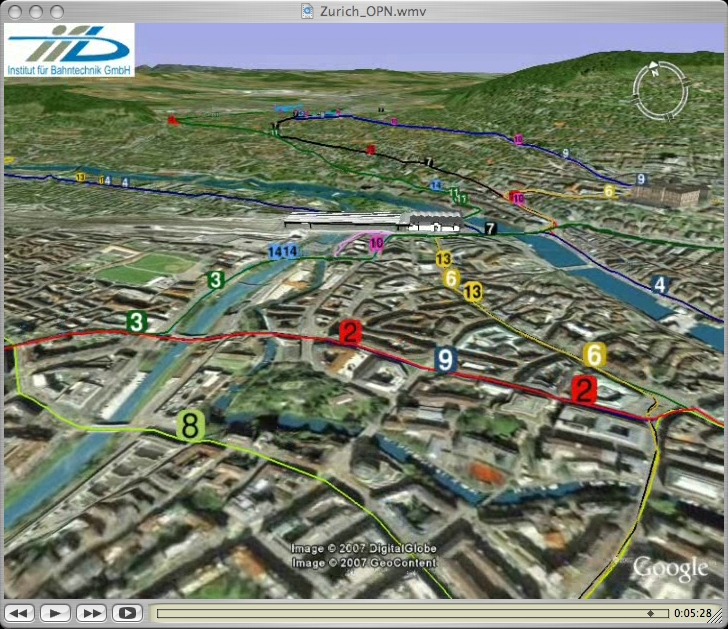 |
More reports and presentations
You’ll find more reports on the use and development of OpenTrack in the German section of our web page and more presentations (in English) in our user workshop section.Video
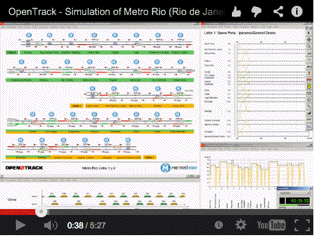
(Per la visualizzazione dei seguenti video é richiesto Apple Quicktime Player o Windows Media Player). Otherwise the the videos can be watched on YouTube.
- Process animation directly on the track layout (1 MB) (.AVI-Format)
- Process animation: The fictitious example Olten (900 kB) (.AVI-Format)
- Animated train graph (400 kB) (.AVI-Format)
- User friendly timetable editing directly within the train graph (388 kB) (.AVI-Format)


Guarda i video di OpenTrack su YouTube (risoluzione non ottimale).
OpenTrack on LinkedIn
Follow us on LinkedIn:
OpenTrack Railway Technology Ltd. on LinkedIn
OpenTrack - Simulation of Railway Networks on LinkedIn
Contatti
Per maggiori informazioni riguardo OpenTrack, contattare:OpenTrack Railway Technology Ltd
Gubelstr. 28
CH - 8050 Zürich
Switzerland
Phone: + 41 - 44 - 310 19 90
Fax: + 41 - 86 - 044 310 19 90
E-Mail: info@opentrack.ch
Per l'Italia:
TPS Srl
Via A. Gramsci 3
40121 - Bologna
Italia
Tel.: + 39 - 051 42 10 982
Fax: + 39 - 051 - 42 19 279
E-Mail: info@opentrack.it
